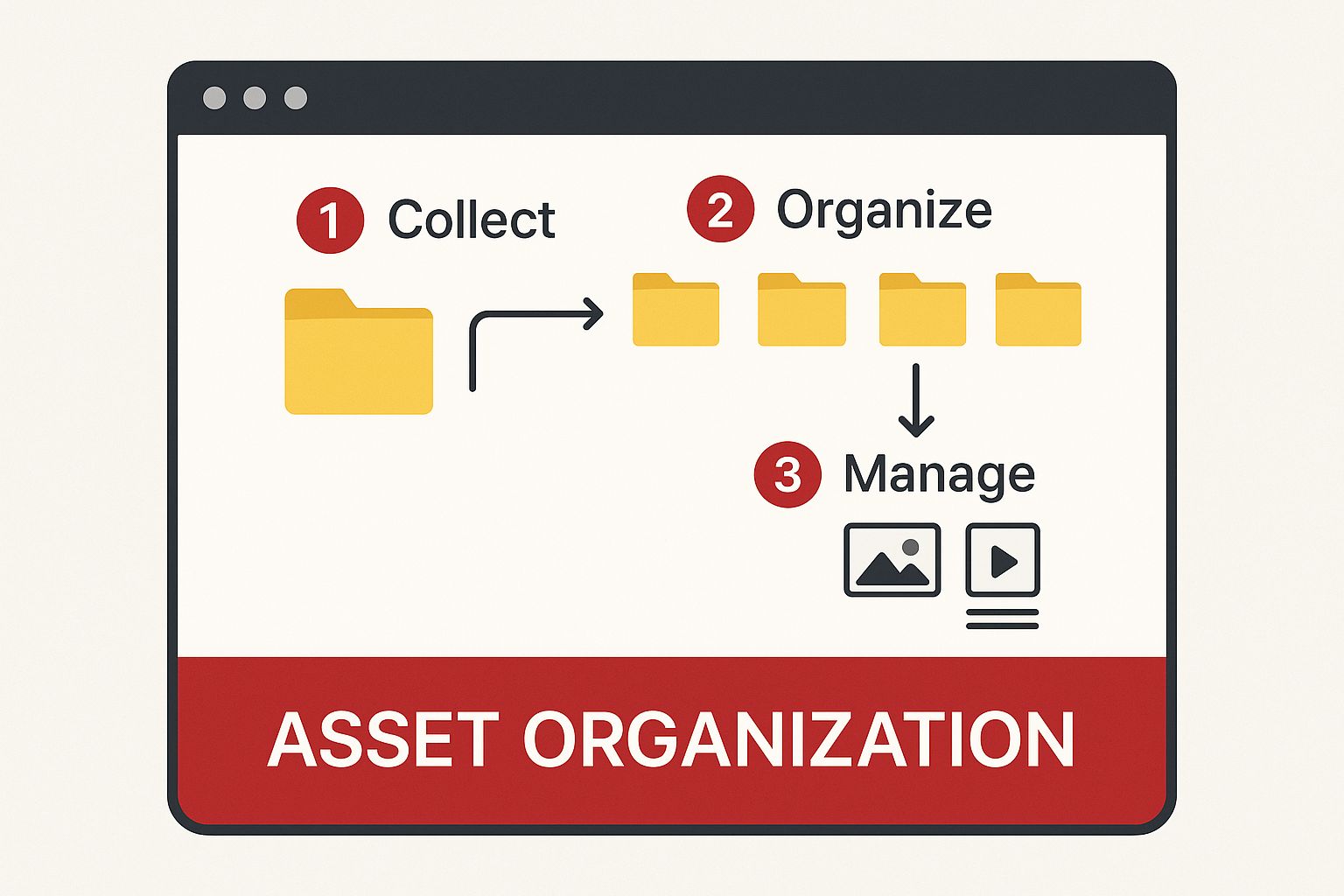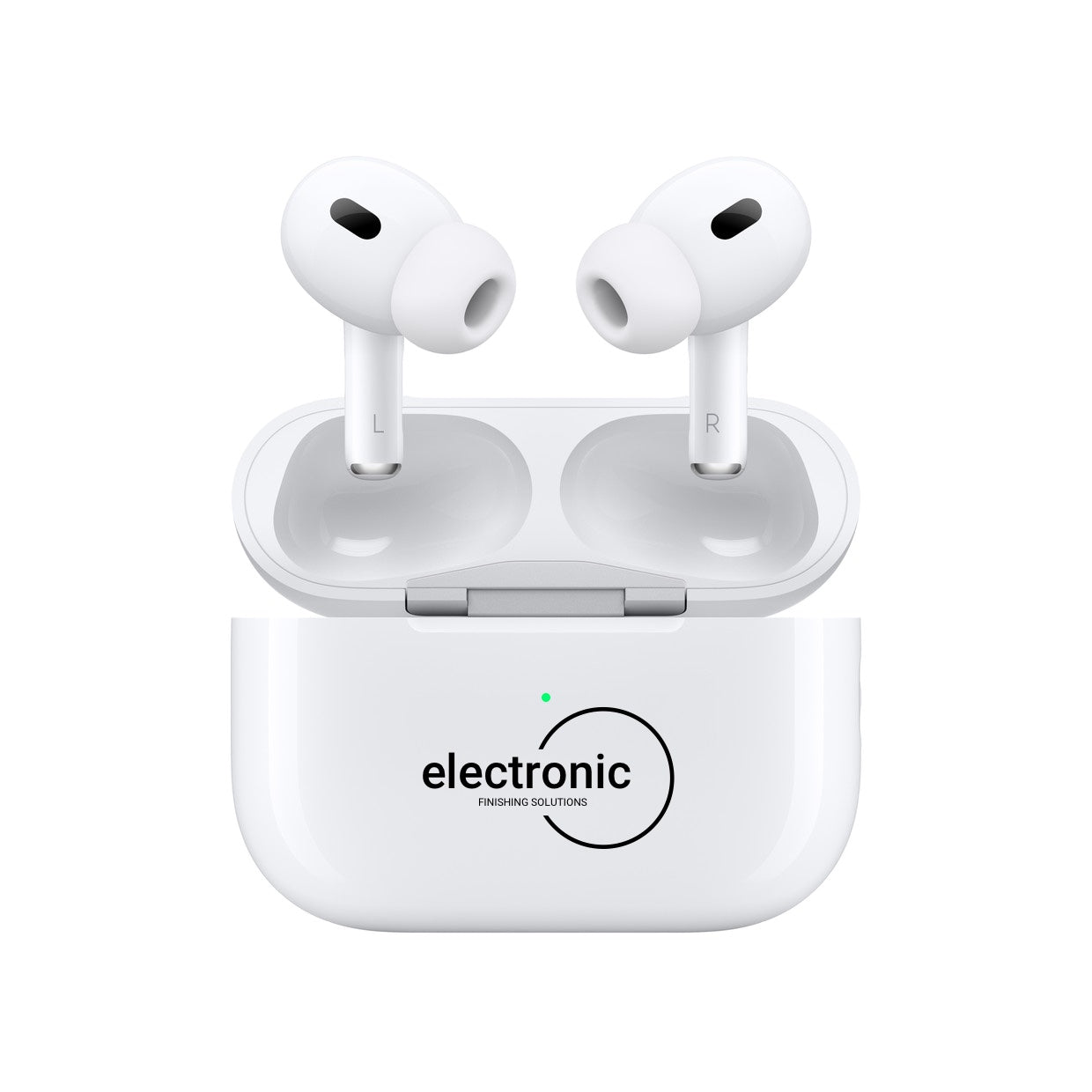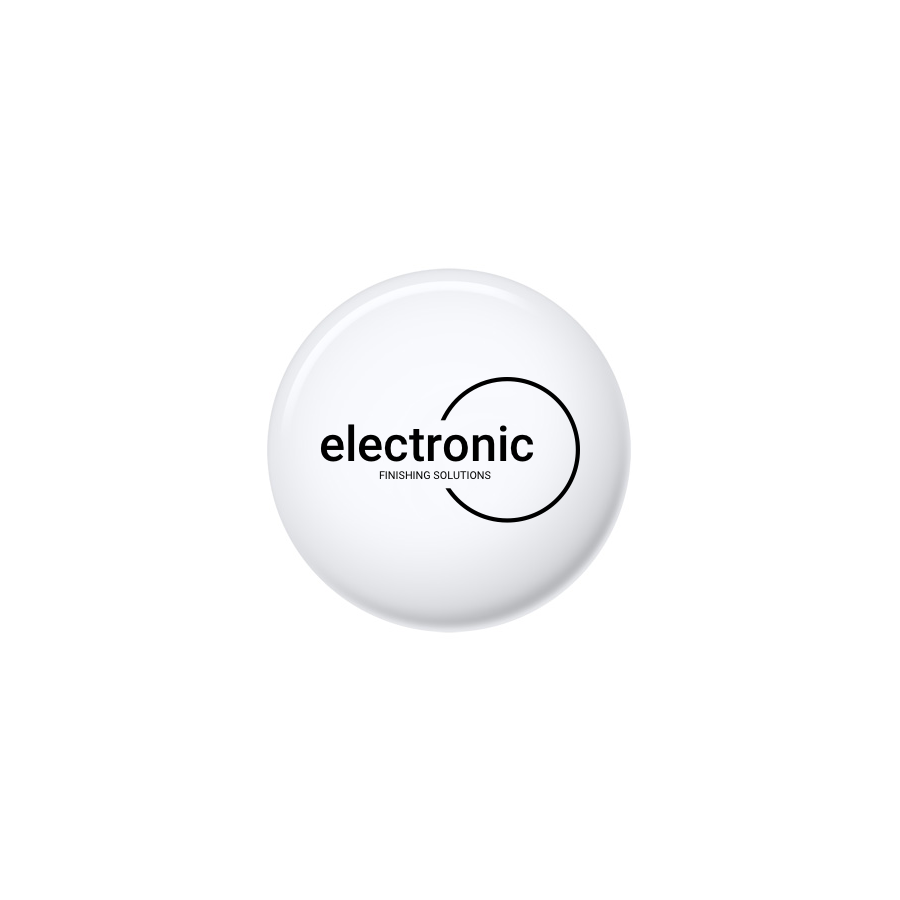Understanding What Really Matters In Brand Asset Management

In today's competitive market, a strong brand is so much more than just a logo. It's the promise you make to your customers, delivered through every single interaction they have with your company. These interactions are shaped by your brand assets, the tangible and intangible elements that represent your brand.
Effectively managing these assets is key for consistent messaging and building strong brand recognition. It's about understanding not only what your assets are, but how they work together to create a cohesive experience. This is the foundation of successful brand asset management.
Defining Your Brand Asset Portfolio
Many businesses prioritize visual elements like logos and color palettes. While these are important, a truly effective brand asset portfolio goes much deeper. It encompasses everything from your mission statement and brand voice to the imagery used in marketing.
Even small details like the music played in your stores or the tone of your customer service emails play a role. Managing brand assets means considering every single touchpoint a customer has with your brand. Think of it as an orchestra: each instrument (asset) contributes to the overall symphony (brand experience).
The Importance of Intangible Assets
Visuals are important, but intangible assets often hold even more weight. These are the less tangible, yet equally important components, such as your brand reputation and customer relationships.
For example, a company known for exceptional customer service has a powerful intangible asset that fosters loyalty. A company with a reputation for innovation can command higher prices and attract top talent. These assets are built over time and are harder to replicate, giving you a real competitive edge. This advantage is directly tied to how well you manage your brand assets.
Why Traditional Approaches Fail
Traditional approaches to brand asset management often fall short by treating assets as isolated elements instead of interconnected parts of a whole. This can easily lead to inconsistent messaging and a fragmented brand experience.
A company might have a stunning logo but use a completely different tone on social media. This disconnect can confuse customers and dilute the brand identity. Managing brand assets is crucial for differentiation in crowded markets and sustained success.
According to the Brand Finance Global 500 2025 report, the world's top 500 brands increased their total brand value by 10% year-on-year, from roughly USD 8.6 trillion in 2024 to almost USD 9.5 trillion in 2025. This highlights the need for a strategic approach.
Moving beyond traditional methods and embracing a more holistic view is essential. This means establishing clear guidelines and processes to ensure consistent brand expression across all channels. This builds the foundation for a strong, recognizable brand that resonates with your audience and fuels growth.
Building Your Strategic Framework That Actually Works
Stop relying on good intentions and start building a system for managing brand assets that delivers measurable results. This means understanding how industry leaders create strategies that align with business objectives and operational realities. A brand asset audit is a crucial first step. This process helps uncover hidden opportunities and identify critical gaps in your current approach.
Conducting a Thorough Brand Asset Audit
A brand asset audit involves taking stock of all your brand elements, from the obvious (logos, fonts) to the less obvious (customer testimonials, brand voice guidelines). This requires a systematic approach.
-
Categorize Assets: Group similar assets together (e.g., visual, written, audio). This simplifies management and analysis.
-
Assess Current Usage: Analyze how each asset is currently used across different platforms and channels. This highlights inconsistencies and areas for improvement.
-
Evaluate Effectiveness: Determine which assets are performing well and which are underperforming. Consider metrics like brand recognition and customer engagement.

This infographic depicts a well-organized digital workspace, visually showcasing efficient asset organization. The clear categorization and readily available thumbnails demonstrate the effectiveness of a structured system. This visual organization translates into improved workflow and faster access to resources.
To better understand the various categories of brand assets and their management, take a look at the table below:
Brand Asset Categories and Management Priorities: A comprehensive breakdown of different brand asset types and their relative importance for strategic management.
| Asset Type | Examples | Management Priority | Update Frequency |
|---|---|---|---|
| Visual Assets | Logos, fonts, color palettes, images, videos | High | As needed, typically annually or bi-annually |
| Written Assets | Brand messaging guidelines, website copy, blog posts, social media content | High | Regularly, depending on content calendar and campaign schedules |
| Audio Assets | Jingles, sound effects, podcasts, voiceovers | Medium | As needed, often tied to specific campaigns or product launches |
| Customer Testimonials | Reviews, case studies, quotes | Medium | Regularly, as new testimonials are gathered |
| Brand Voice Guidelines | Tone of voice, language style, grammar rules | High | Infrequently, typically only when major brand updates occur |
This table highlights the importance of prioritizing core brand assets like logos and messaging, while also demonstrating how elements like customer testimonials require regular updates to stay relevant. Effective management of these assets is crucial for maintaining a consistent brand identity.
Establishing Clear Ownership and Governance
Once you understand your assets, establish clear ownership structures and governance policies. This ensures consistent brand expression across all channels. This doesn't need to be overly complex; it's about providing helpful guidelines.
-
Assign Ownership: Designate individuals or teams responsible for specific asset categories. This promotes accountability.
-
Develop Brand Guidelines: Create clear documentation outlining how assets should be used. This serves as a reference point for everyone. For more insights, explore Digital Asset Management Solutions.
-
Implement Approval Processes: Establish a system for reviewing and approving any new or updated assets. This ensures consistency and prevents unauthorized use.
Developing a Roadmap for Success
With a solid foundation, develop a roadmap that delivers both immediate wins and long-term strategic value. This roadmap should outline specific goals, timelines, and key performance indicators (KPIs). For additional guidance on corporate branding strategies, check out this helpful resource: How to master corporate branding strategies.
-
Prioritize Quick Wins: Identify areas where small changes can have a big impact. This builds momentum.
-
Focus on Long-Term Goals: Align your brand asset management strategy with your overall business objectives. This ensures that your efforts contribute to long-term success.
-
Track and Measure Progress: Regularly monitor your KPIs to assess the effectiveness of your strategy. This allows for adjustments and optimization. A well-managed brand asset strategy streamlines operations and strengthens your brand identity, ultimately leading to increased recognition and a more cohesive customer experience.
Choosing Digital Solutions That Scale With Your Growth

The right technology can make all the difference when it comes to managing your brand assets. Moving from a struggle to seamless brand consistency is often a matter of having the right tools. Selecting the right Digital Asset Management (DAM) platform is a key piece of this puzzle. It's essential to understand which features will truly improve your daily operations and contribute to your organization's growth over the long term.
Essential Features of a Modern DAM Platform
Modern DAM platforms offer a wide variety of features. However, some are more important than others for effective brand asset management. Intuitive search capabilities are at the top of the list. Being able to quickly locate the exact asset you need, no matter the file type, saves time and reduces frustration.
-
AI-Powered Organization: Artificial intelligence (AI) is changing how we organize and manage assets. Features like automatic tagging and metadata generation streamline workflows and make assets easier to find.
-
Version Control: Keeping track of different versions of assets is crucial for any business. A solid DAM system meticulously tracks these changes, ensuring you always access the correct file version.
-
User Permissions: Controlling who can access which assets is vital for brand integrity. User permissions define who can view, edit, and download specific files, adding an essential layer of security.
-
Integration Capabilities: Your DAM platform should work smoothly with other tools in your marketing technology stack. Seamless integration with tools like Content Management Systems (CMS) and social media platforms is crucial.
These features are essential components of a highly efficient and effective brand asset management system. Ultimately, this allows your organization to maintain brand consistency across all interactions with your customers.
Evaluating Platform Options Based on Your Needs
Not all DAM platforms are the same. It's important to evaluate your options based on your organization's specific needs. Consider factors like the size of your team, your budget, and your current technology infrastructure.
-
Scalability: Choose a platform that can adapt as your organization grows. A platform that works well for a small team today may not be the best fit as your team expands.
-
Budget Constraints: DAM platforms are available at a range of price points. Set a budget and look for a platform that provides the features you need within your financial means.
-
Integration Requirements: Make sure the platform you choose integrates with your current software and workflows to avoid disruptions and ensure a streamlined process.
Real-World Implementation and User Adoption
Successfully implementing a DAM platform requires careful planning and execution, especially when moving from manual processes. Getting everyone on board with the new system is often the biggest challenge. User adoption is key, so ensure your team understands the platform's benefits and receives adequate training.
Providing clear documentation and ongoing support can encourage your team to use the new system. Sharing success stories from other companies using DAM platforms can also be very motivating. Focus on how the platform optimizes workflows and simplifies daily tasks. This will demonstrate a clear return on investment for the new technology.
By carefully evaluating your needs and selecting the right DAM platform, you can effectively manage your brand assets and ensure long-term brand consistency. Understanding potential implementation challenges and addressing them proactively will make the transition smoother and maximize the return on your DAM investment.
Maintaining Consistency Across Every Customer Touchpoint
Maintaining brand consistency is more than just using the same logo everywhere. It's about creating a unified and recognizable experience for your customers, regardless of how they interact with your company. This builds trust and strengthens your brand identity. This section explores proven strategies to ensure your brand message remains consistent across every platform, from your website and social media presence to physical locations, partner networks, and even internal communications.
Developing Comprehensive Brand Standards
Successful organizations recognize the value of well-defined brand standards. These standards serve as a guide for representing your brand, offering clear direction while allowing for flexibility and creative adaptation across various contexts. Think of them as the blueprint for your brand's identity. They ensure every element, from color palettes and fonts to messaging and visual elements, aligns with your core values.
For example, your brand standards might detail the specific shade of blue used in your logo, the preferred font for headlines, and the tone of voice adopted for social media posts. This level of detail helps maintain a cohesive brand experience across all channels. Furthermore, consider how your brand standards translate to physical materials like business cards, brochures, and signage in physical locations.
Real-World Examples of Multi-Channel Brand Management
Many companies successfully manage their brand across multiple channels. Analyzing their strategies can provide valuable lessons for your own brand management. Consider how companies like Apple maintain a consistent brand experience across their retail stores, website, and product packaging. Their minimalist design and focus on user experience are evident in every customer touchpoint. This careful coordination of brand elements creates a strong and recognizable brand identity. You might also be interested in: How to boost your brand with sustainable promotional items.
Training, Monitoring, and Enforcement
Maintaining brand consistency requires more than just setting standards. It also requires actively training your team, monitoring compliance, and enforcing these guidelines. This is especially critical in larger organizations or those operating in diverse markets. Regular training educates employees on the importance of brand consistency and provides practical guidance on applying brand standards in their daily work. In asset management, brand asset management is key for building client trust and achieving a competitive advantage.
The Broadridge Fund Brand 50 report of 2025 highlights that leading fund brands maintain their dominance primarily through strong brand recognition and perceived solidity. Find more detailed statistics here. Consistent monitoring of your brand’s presence helps identify deviations from established standards. This could involve reviewing marketing materials, social media posts, or customer feedback.
Once inconsistencies are identified, corrective action can be taken to address them and reinforce brand guidelines. This ongoing process of monitoring and refinement is essential for maintaining a strong and consistent brand identity. Empowering local teams to adapt your brand messaging to their specific audiences while still adhering to core brand principles is crucial. This requires clear communication, continuous feedback, and a flexible framework that allows for tailored messaging within defined boundaries.
Measuring Performance And Maximizing Your Brand ROI
Effective brand asset management is a dynamic process. It requires ongoing optimization based on actual performance data, not just assumptions. This involves establishing key performance indicators (KPIs) to gauge the effectiveness of your brand assets. These can range from simple usage analytics to more nuanced brand perception measures. Tracking these metrics provides valuable insights into what resonates with your audience, what falls flat, and how to adjust your strategy for optimal impact.
Establishing Meaningful Metrics
Choosing the right metrics is paramount. Usage analytics, such as how often an asset is downloaded or used, offer a basic understanding. However, it's important to dig deeper. Examine engagement rates with your brand content. Are people interacting with your social media posts? Are they clicking through your email campaigns? These metrics reveal how effectively your assets resonate with your audience.
Also, consider the conversion impact of your brand assets. Are they contributing to lead generation or sales? This demonstrates the tangible business value of effective brand asset management. Don't overlook brand perception studies to understand how your audience perceives your brand. This qualitative data complements quantitative metrics, providing a more complete picture of brand performance.
Regular Brand Asset Reviews and A/B Testing
Regular brand asset reviews are essential. They allow you to identify underperforming elements and understand why they aren't connecting with your audience. This should be a systematic process involving a thorough analysis of usage data, engagement metrics, and customer feedback. Learn more in our article about How to Improve Brand Visibility.
For instance, if an image isn't performing well on social media, it could be due to poor image quality, irrelevant messaging, or ineffective targeting. A/B testing different versions of your brand assets can provide valuable data on what resonates best. This data-driven approach allows for optimization and maximum impact. Maintaining consistency requires a central repository, often called a single source of truth.
Leveraging Customer Feedback and Calculating ROI
Customer feedback is invaluable. Use surveys, social media listening, and customer reviews to gain insights into brand perception and audience preferences. This data informs your brand asset strategy, ensuring alignment with customer expectations.
Ultimately, demonstrating the return on investment (ROI) of your brand asset management efforts is crucial. This involves connecting your activities to tangible business outcomes. For example, if a rebranding campaign leads to a 10% increase in sales, this growth can be directly attributed to your brand asset management strategy. This data justifies budgets, guides future strategies, and demonstrates the value of effective brand asset management to stakeholders. The trend toward leaner operations is also linked to strategic brand asset management. The 2025 Global Asset Management Report by BCG highlights how companies are streamlining operations for increased resilience in uncertain markets. By consistently measuring and optimizing your brand assets, you ensure they are working effectively, driving growth, and building long-term brand value.
Scaling Brand Management Across Global Organizations
Expanding into international markets offers exciting growth opportunities, but also presents unique challenges in managing brand assets. Maintaining a consistent brand identity while respecting cultural nuances across different regions requires a strategic and thoughtful approach. This means establishing clear frameworks that define which brand elements remain globally standardized and which are adapted to resonate with local markets. Striking this balance is essential for both global brand integrity and local market success.
Balancing Global Consistency and Local Adaptation
Think of your brand as a complex puzzle. Some pieces (your core elements like logo, mission, and values) remain constant, forming the unshakeable foundation. Other pieces (such as messaging, imagery, and even marketing channels) can be adapted to fit the specific "shape" of each local market. For example, your core brand message might remain the same globally, but the language, visuals, and channels you use to communicate it might need to change to resonate with different cultural contexts.
This goes beyond simple translation; it requires a deep understanding of cultural sensitivities. A direct translation of your slogan might sound unnatural or even offensive in another language. Imagery that resonates positively in one culture could be misinterpreted or even considered inappropriate in another. Finding the right balance between global consistency and local relevance is crucial for building trust and engagement with diverse audiences.
Learning From Global Brand Success Stories
Many global brands have successfully navigated this delicate balancing act. Consider McDonald's, which maintains core branding elements globally (like the Golden Arches and consistent restaurant design), while also adapting its menu to incorporate local flavors. This strategy allows them to maintain brand recognition while catering to regional preferences. Similarly, Nike adapts its marketing campaigns to feature local athletes and connect with specific cultural values, all while retaining its core brand message of athletic achievement and inspiration. Analyzing these successful strategies provides valuable insights for effectively managing brand assets across diverse markets.
You might be interested in learning more about measuring brand awareness: How to measure brand awareness and boost growth. Examining successful case studies can help you identify best practices for regional asset libraries, local compliance measures, and effective cross-cultural brand expression.
Practical Solutions for Global Brand Management
Managing brand assets effectively across multiple time zones and languages requires practical, scalable solutions. Consider using cloud-based Digital Asset Management (DAM) systems like Bynder or Widen to ensure everyone has access to the latest approved assets, regardless of their location. These systems can also manage version control, ensuring consistency and eliminating the risk of using outdated materials.
To further streamline global brand management, implement the following strategies:
-
Centralized Asset Library: This creates a single source of truth for all brand assets, making it easy for global teams to access and utilize approved materials.
-
Workflow Automation: Automating tasks like translation and file conversion streamlines processes and reduces the risk of errors.
-
Clear Communication Channels: Establishing regular and transparent communication channels ensures everyone is aligned and informed about brand updates and guidelines.
Addressing language variations requires more than just translation. It involves considering cultural nuances and adapting your messaging to resonate authentically with different audiences. This often involves collaborating with local marketing teams who possess a deep understanding of the cultural context. Respecting cultural sensitivities is paramount. This extends beyond simply avoiding offensive content; it requires actively understanding and incorporating local customs and traditions into your brand messaging and overall strategy.
Let's explore some common challenges and solutions in more detail:
Introducing a table that outlines common challenges faced by global organizations and proven solutions for effective brand asset management:
Global Brand Asset Management Challenges and Solutions
| Challenge | Impact | Solution Strategy | Success Metrics |
|---|---|---|---|
| Inconsistent Brand Messaging Across Regions | Diluted brand identity, confused customers | Centralized asset library, clear brand guidelines, local marketing team collaboration | Brand consistency score, customer satisfaction surveys |
| Difficulty Managing Assets Across Time Zones | Delays in project completion, version control issues | Cloud-based DAM system, established communication protocols | Project completion rate, asset usage tracking |
| Cultural Misinterpretation of Brand Elements | Damaged brand reputation, negative customer perception | Cultural sensitivity training, local market research | Social listening sentiment analysis, brand perception surveys |
| Lack of Local Market Expertise | Ineffective marketing campaigns, missed opportunities | Local marketing hires, partnerships with local agencies | Market share growth, campaign ROI |
This table highlights the importance of proactive strategies for overcoming the challenges of managing a global brand. By implementing robust solutions, organizations can maintain brand consistency, improve operational efficiency, and maximize their impact in diverse markets.
By proactively addressing these challenges of managing time zones, language, and cultural nuances, you can maintain operational efficiency and brand integrity across diverse markets and teams. This ensures your brand message remains consistent and effective, regardless of where it's delivered. This thoughtful, localized approach empowers global brands to connect with their target audiences on a deeper, more personal level.
Key Takeaways For Long-Term Brand Asset Success
Building a successful brand takes more than just a memorable logo and a catchy slogan. It requires a strategic approach to managing all of your brand assets. These are the visual, written, audio, and intangible elements that represent your company. This section outlines key strategies for long-term brand asset success, providing a roadmap for a system that delivers lasting value.
Understanding Your Brand Assets
Before effectively managing your brand assets, you need a clear understanding of what they are.
- Visual Assets: Logos, color palettes, typography, imagery, and video content. These recognizable elements should be meticulously managed for consistency.
- Written Assets: Messaging guidelines, website copy, blog posts, social media content, and marketing materials. Consistent written content reinforces your brand voice and values.
- Audio Assets: Jingles, sound effects, podcasts, and voiceovers. These auditory elements contribute to a rich brand experience. They should align with your overall brand identity.
- Intangible Assets: Brand reputation, customer relationships, and company culture. These often-overlooked assets can be your most valuable, differentiating you from competitors.
Building a Strategic Framework
Effective brand asset management requires a strategic framework.
- Conducting a Brand Audit: Take stock of all your brand assets, categorize them, assess their current usage, and evaluate their effectiveness. This reveals strengths, weaknesses, and areas for improvement.
- Establishing Clear Ownership: Designate specific individuals or teams responsible for managing different asset categories. This promotes accountability and prevents inconsistencies.
- Developing Brand Guidelines: Create clear documentation outlining how each asset should be used. This serves as a reference and ensures consistent brand expression.
- Implementing Approval Processes: Establish a system for reviewing and approving any new or updated assets. This prevents unauthorized use and maintains brand integrity.
Choosing the Right Technology
The right technology can streamline your brand asset management efforts.
- Digital Asset Management (DAM) Systems: A centralized platform for storing, organizing, and accessing all your brand assets. Look for features like intuitive search, version control, user permissions, and integration capabilities.
Maintaining Consistency Across Touchpoints
Brand consistency is paramount. It builds trust and recognition.
- Developing Comprehensive Brand Standards: Create detailed guidelines specifying how your brand should be represented across different platforms and channels.
- Training Your Team: Educate employees on the importance of brand consistency. Provide them with the knowledge and tools to adhere to brand standards.
- Monitoring and Enforcing Guidelines: Regularly review your brand’s presence across all touchpoints. Take corrective action when necessary to ensure compliance.
Measuring Performance and ROI
Maximize the impact of your brand asset management by measuring its performance.
- Establish Key Performance Indicators (KPIs): Track metrics like asset usage, engagement rates, conversion impact, and brand perception.
- Conduct Regular Reviews: Analyze your KPIs to identify areas for improvement and optimize your strategy.
- Calculate ROI: Demonstrate the tangible business value of your efforts by linking them to measurable business outcomes.
Scaling Brand Management for Global Organizations
For multinational companies, managing brand assets adds another layer of complexity.
- Balancing Global Consistency and Local Adaptation: Determine which brand elements should remain standardized and which should be adapted to resonate with local markets.
- Developing Regional Asset Libraries: Create localized versions of your assets, ensuring they align with your core brand identity.
- Addressing Language and Cultural Nuances: Translate and adapt your messaging, being mindful of cultural sensitivities.
By implementing these key takeaways, you can build a robust brand asset management system. This strengthens your brand identity, improves operational efficiency, and drives measurable business results. A well-managed brand identity is a powerful asset. It can differentiate you from competitors and fuel long-term growth.
Ready to elevate your brand with high-quality, customizable promotional electronics? Contact Electronic Finishing Solutions today! Learn how EFS can help amplify your brand.



